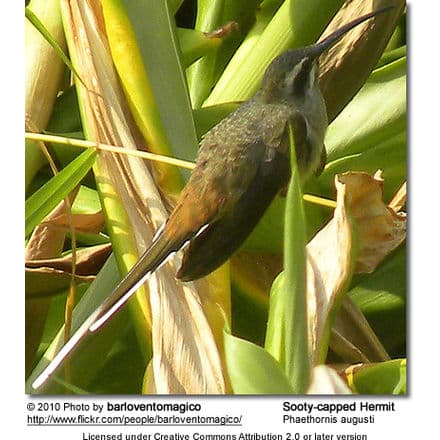Pale-tailed Barbthroats
The Pale-tailed Barbthroat (Threnetes leucurus) is a South American hermit (hummingbird) that occurs naturally in the Amazon Basin proper and bordering countries, Brazil, Bolivia, Colombia, Ecuador, Peru, French Guiana, Guyana, Suriname, and Venezuela.
They inhabit subtropical or tropical moist lowland forests and swamps.
The Pale-tailed Barbthroat is sometimes considered conspecific (same species) with the Sooty Barbthroat, but there are some physical differences that support the theory that they are two separate species.
Alternate (Global) Names:
French: Ermite à queue blanche; German: Hellschwanzeremit; Spanish: Pico de Sable de Cola Blanca; Italian: Colibrì barbuto codabianca; Dutch:: Zwartkeel-baardkolibrie
Description
The Pale-tailed Barbthroat averages 10 – 11 cm (3.9 – 4.3 inches) in length. Its upper plumage is mostly an iridescent coppery-green; the crown is edged buffy. At the sides of the head, the coppery color is intensified, tying into the coppery-colored throat. The under plumage is paler with greenish-coppery spots.
The Pale-tailed Barbthroat and the Sooty Barbthroat are the only hermits with a black throat which emphasizes the whitish stripe next to the beak down to the throat (commonly referred to as “malar stripe”). The upper breast is dusky bronze-green and the lower breast is buffy white. The central tail feathers are greener than the back with white tips. The outer tail feathers are pale buff and the outermost feathers have a diagonal black band and white tip. The bill is slightly curved and is black with white borders. Its legs are pinkish.
The female’s plumage is generally duller.
Similar species: It looks similar to the Pale-tailed Barbthroat; but has a different tail pattern.
Nesting / Breeding
Hummingbirds in general are solitary and neither live nor migrate in flocks; and there is no pair bond for this species – the male’s only involvement in the reproductive process is the actual mating with the female.
The female alone protects and feeds the chicks with regurgitated food (mostly partially digested insects since nectar is an insufficient source of protein for the growing chicks). The female pushes the food down the chicks’ throats with her long bill directly into their stomachs.
As is the case with other hummingbird species, the chicks are brooded only the first week or two, and left alone even on cooler nights after about 12 days – probably due to the small nest size. The chicks leave the nest when they are about 23-24 days old. The female raises one brood a season.
Diet / Feeding
The Pale-tailed Barbthroats primarily feed on nectar taken from a variety of brightly colored, scented small flowers of trees, herbs, shrubs, and epiphytes. They favor flowers with the highest sugar content (often red-colored and tubular-shaped).
Hummingbird Resources
- Hummingbird Information
- Hummingbird Amazing Facts
- Attracting Hummingbirds to Your Garden
- Hummingbird Species
- Feeding Hummingbirds



